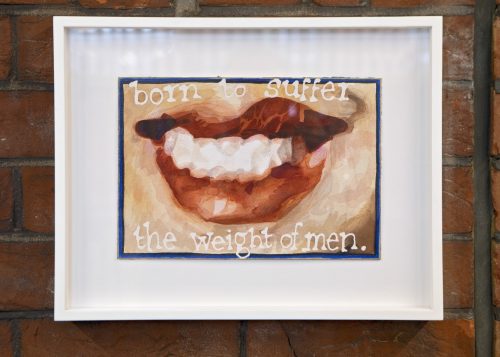
Image: Jade Montserrat, Born to Suffer the Weight of Men, installation view, 2020. Photograph by George Torode.
In December 2019 Jade Montserrat’s exhibition at the Stuart Hall Library addressed the multitude of voices and conversations nurturing the artist’s work and the generative relationship between image and text.
Iniva’s Simina Neagu sat with the artist to discuss her multi-faceted practice. Jade’s work is informed by the interplay of art and activism and the literary traditions of the Black Atlantic. Combining quotations with her own writing, Jade refers to her watercolours and drawings as dissemination tools. An underlying common theme in the artist’s practice is an ongoing exploration of building spaces of belonging and care.
The figure plays a significant role in the work that is shown at the library. In particular, a series of works, Ecclesiastes, installed in the library’s individual study spaces features silhouettes strewn with minuscule text and dots. Could you consider this body of work having a bodily function?
I think we could probably liken these works to skin. Mostly because it’s something that can take on different reflecting qualities. Skin cells wrap our bodies, while showing us what we’re about. It’s the first thing that you see and distinguishes us from one another. The watercolours would point to different dynamics of skin, different times, different ages, different sicknesses. They’re also adorned skins.
They are also entry points, right?
Yes, absolutely. I’m also in Anne Anlin Cheng territory at the moment, reading “Second Skin: Josephine Baker & the Modern Surface”. At the moment I’m also reading “Glenn Ligon: Encounters and Collisions” and I also like that phrase. There is a collaboration and dialogue between each “unit” of the body of work, so to speak. From the watercolours through to the more nuanced understandings of the work I make to the more conceptual projects that are more about verbal dialogue.
Staying with this idea of the body and since you are currently in the final stages of writing your PhD, I was wondering about how you negotiate different strands of your work, in particular the tension between embodied and academic knowledge that you seem to constantly navigate. Do you experience this tension and if so, how do you work through it?
Yes, there’s definitely tension and that has to do with education, I would say. Thinking about academia, I’m really lucky that my supervisors and thinkers that are informing my work are centering the body and its traumas from a somatic and embodied vantage. I’ve only just started reading this book “Volatile Bodies. Toward a Corporeal Feminism” by Elizabeth Grosz and she speaks about male philosophers and thinking through the body as a more contained site. There’s a quote in here: “this book is a refiguring of the body so it moves from the periphery to the center of the analysis, so that now it can be understood as the very stuff of subjectivity”.
What I’m wondering about is how we locate our body’s needs and able to voice the silences within our bodies at a much earlier stage in our development. So that’s how the performances, watercolours or installations work together in locating bodies as ways to communicate how we’re confined and how we might then find new pedagogies. And how we can define human needs alongside human rights, if that makes sense.
And perhaps linked to this idea of new pedagogies, another thing that I am curious about is your relationship to authorship and collaboration. We have selected a series of publications by artists such as Ingrid Pollard and Coco Fusco and thinkers such as Fred Moten, bell hooks and Sara Ahmed to accompany your exhibition. In a way, we can think of them as some of your conversation partners. Coming back to the watercolours, they might include quotes from a book or be a snippet of discussion. It seems that you’re sometimes playing with the notion of authorship and voice and never working in isolation.
Indeed, I am never working in isolation, I am always dedicated to reading, listening to music, face to face conversations. In terms of authorship, I think it’s linked to my desire to advocate on behalf of public spaces, with an emphasis on our libraries which have been underfunded and closed. And part of the work is wholly linked to my subjectivity because it’s a continuation, celebration and transcription of a bibliography that has no limits and no end. Some of what I read corresponds to what’s absent in the core curriculum and national consciousness. There’s an absented bibliography that I work with.
Also I am in a public space, I have the capacity to highlight structures of words that will change how we formulate our own thoughts. Also it’s quite difficult because I’m appropriating and keeping on top of that is quite a challenge and requires a dialogue. The text panels, installations and watercolours require a prompt to say that arrangement of words is taken from such and such book. Because it’s not readily apparent in the work itself. It requires more work after the work itself. The work itself is incomplete so those conversations can develop.